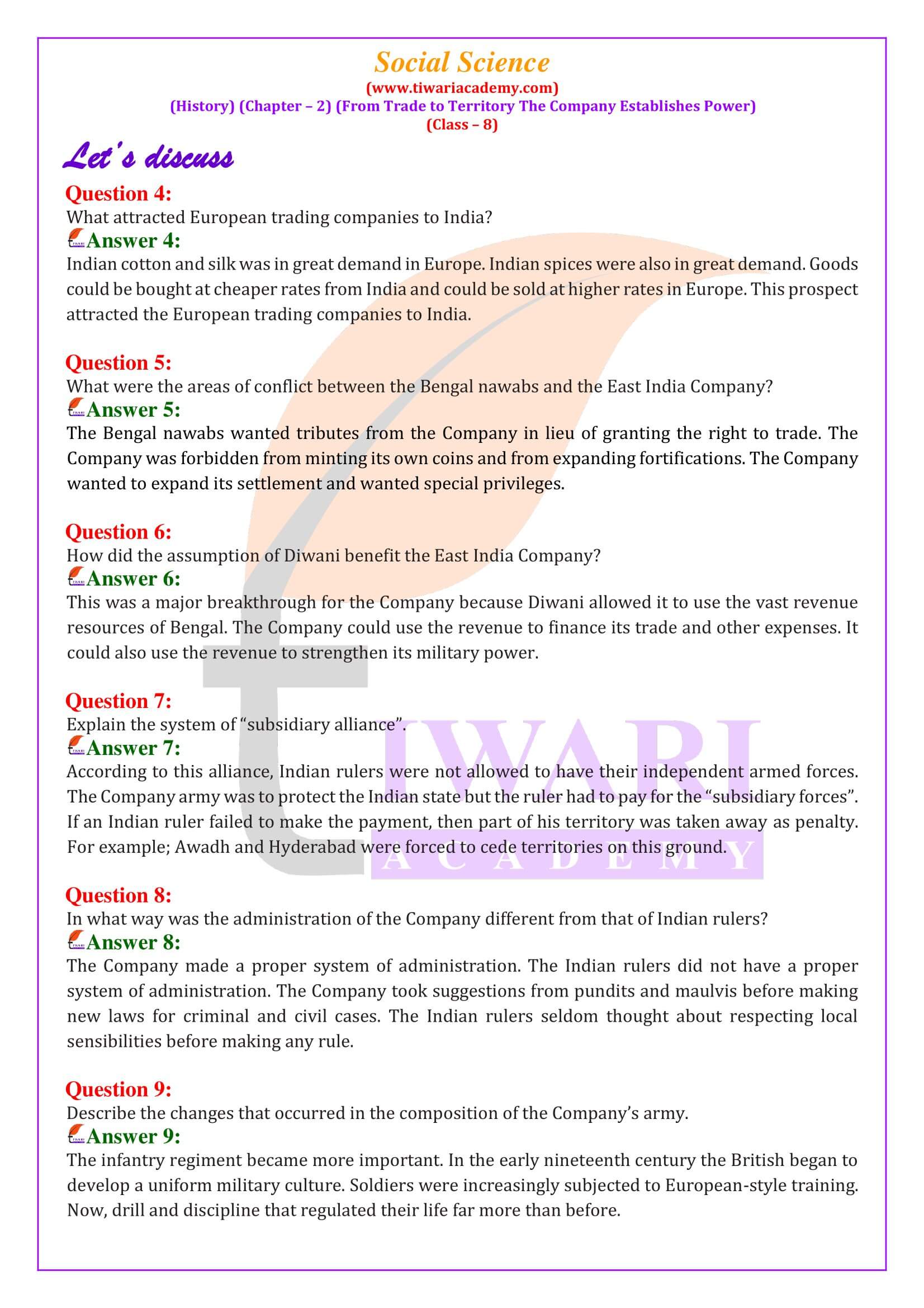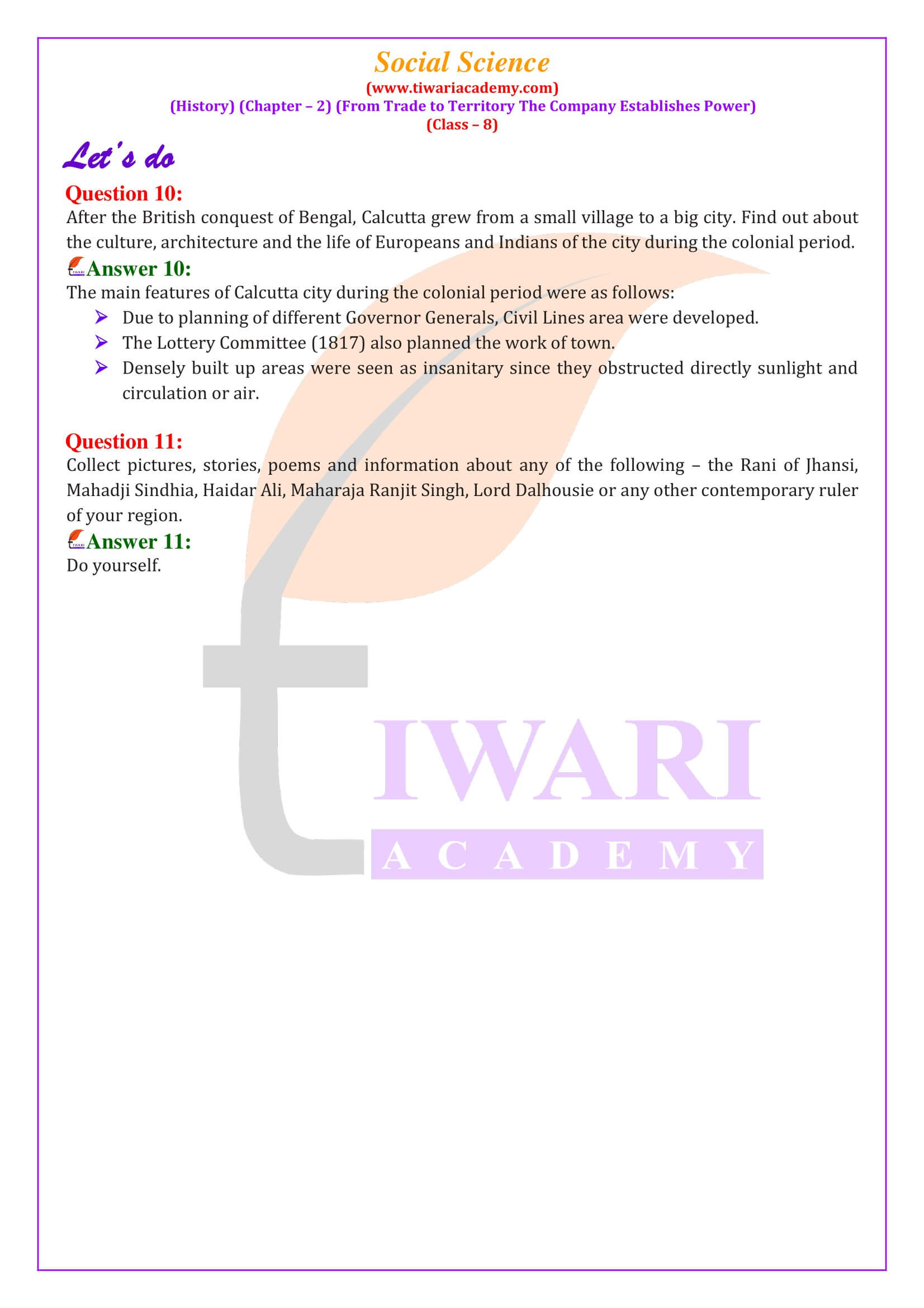NCERT Solutions for Class 8 Social Science History Chapter 2 From Trade to Territory in English and Hindi Medium modified for new academic session 2025-26. The solutions and explanation of questions in chapter 2 of class 8th History is revised as per the new NCERT textbook issued for 2025-26 exams.
NCERT Solutions for Class 8 Social Science History Chapter 2
Download NCERT Solutions 2025-26 for Maths, Science and Hindi also in PDF file format. Discuss Your Questions with your friends and share it in the world of knowledge through Discussion Forum.
Class 8 History Chapter 2 Question Answers
CBSE Solutions for Class 8 Social Science History Chapter 2 From Trade to Territory is given below updated for session 2025-26. Download NCERT Books for offline use or use as it is without downloading online.
Class 8 History Chapter 2 Extra Questions
East India Company begins trade in Bengal. How?
The first English factory was set up on the banks of the river Hugli in 1651. This was known at that time as “factors”, operated. The factory had a warehouse where goods for export were stored and it had offices where Company officials sat. As trade expanded, the Company persuaded merchants and traders to come and settle near the factory.
By 1696 it began building a fort around the settlement. Two years later it bribed Mughal officials into giving the Company zamindari rights over three villages. One of these was Kalikata, which later grew into the city of Calcutta or Kolkata as it is known today. It also persuaded the Mughal emperor Aurangzeb to issue a farman granting the Company the right to trade duty free.
How trade led to battles?
After the death of Aurangzeb, the Bengal nawabs asserted their power and autonomy, as other regional powers were doing at that time. Murshid Quli Khan was followed by Alivardi Khan and then Sirajuddaulah as the Nawab of Bengal. They refused to grant the Company concessions, demanded large tributes for the Company’s right to trade, denied it any right to mint coins and stopped it from extending its fortifications. It was refusing to pay taxes, writing disrespectful letters, and trying to humiliate the nawab and his officials. The Company on its part declared that the unjust demands of the local officials were ruining the trade of the Company and trade could flourish only if the duties were removed. It was also convinced that to expand trade it had to enlarge its settlements, buy up villages, and rebuild its forts.
| Class: 8 | Social Science |
| Subject: | History |
| Chapter 2: | From Trade to Territory |
| Content: | NCERT Question Answers |
| Content Type: | Images and Online Text |
Do you Know
After Aurangzeb there was no powerful Mughal ruler, but Mughal emperors continued to be symbolically important. In fact, when a massive rebellion against British rule broke out in 1857, Bahadur Shah Zafar, the Mughal emperor at the time, was seen as the natural leader. Once the revolt was put down by the company, Bahadur Shah Zafar was forced to leave the kingdom, and his sons were shot in cold blood.
Important Questions on 8th History Chapter 2
Fill in the blank: The British conquest of Bengal began with the Battle of ___________.
The British conquest of Bengal began with the Battle of Plassey.
State whether true or false: The Mughal empire became stronger in the eighteenth century.
The Mughal empire became stronger in the eighteenth century. False
What attracted European trading companies to India?
Indian cotton and silk was in great demand in Europe. Indian spices were also in great demand. Goods could be bought at cheaper rates from India and could be sold at higher rates in Europe. This prospect attracted the European trading companies to India.
What were the areas of conflict between the Bengal nawabs and the East India Company?
The Bengal nawabs wanted tributes from the Company in lieu of granting the right to trade. The Company was forbidden from minting its own coins and from expanding fortifications. The Company wanted to expand its settlement and wanted special privileges.
How did the assumption of Diwani benefit the East India Company?
This was a major breakthrough for the Company because Diwani allowed it to use the vast revenue resources of Bengal. The Company could use the revenue to finance its trade and other expenses. It could also use the revenue to strengthen its military power.
Explain the system of “subsidiary alliance”.
According to this alliance, Indian rulers were not allowed to have their independent armed forces. The Company army was to protect the Indian state but the ruler had to pay for the “subsidiary forces”. If an Indian ruler failed to make the payment, then part of his territory was taken away as penalty. For example; Awadh and Hyderabad were forced to cede territories on this ground.
In what way was the administration of the Company different from that of Indian rulers?
The Company made a proper system of administration. The Indian rulers did not have a proper system of administration. The Company took suggestions from pundits and maulvis before making new laws for criminal and civil cases. The Indian rulers seldom thought about respecting local sensibilities before making any rule.
Describe the changes that occurred in the composition of the Company’s army.
The infantry regiment became more important. In the early nineteenth century the British began to develop a uniform military culture. Soldiers were increasingly subjected to European-style training. Now, drill and discipline that regulated their life far more than before.
After the British conquest of Bengal, Calcutta grew from a small village to a big city. Find out about the culture, architecture and the life of Europeans and Indians of the city during the colonial period.
The main features of Calcutta city during the colonial period were as follows: Due to planning of different Governor Generals, Civil Lines area were developed. The Lottery Committee (1817) also planned the work of town. Densely built up areas were seen as insanitary since they obstructed directly sunlight and circulation or air.
Important Notes on 8th History Chapter 2
1. Mercantile: A business enterprise that makes profit primarily through trade, buying goods cheap and selling them at higher prices.
2. Farman: A royal edict, a royal order.
3. Puppet: Literally, a toy that you can move with strings. The term is used disapprovingly to refer to a person who is controlled by someone else.
4. Mufti: A jurist of the Muslim community responsible for expounding the law that the qazi would administer.
5. Impeachment: A trial by the House of Lords in England for charges of misconduct brought against a person in the House of Commons.






